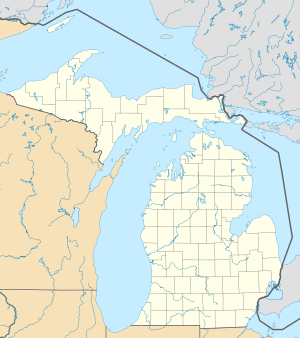Milwaukee Clipper
 |
|
| History | |
|---|---|
|
|
|
| Name: |
|
| Owner: |
|
| Route: | Muskegon to Milwaukee |
| Builder: |
|
| Launched: | 22 December 1904 |
| Maiden voyage: | As rebuilt, 3 June 1941 |
| Fate: | Museum Ship |
| Status: | Docked in Muskegon, Michigan |
| General characteristics | |
| Tonnage: | |
| Length: | 361 ft (110 m) |
| Beam: | 45 ft (14 m) |
| Depth: | 28 ft (8.5 m) |
| Installed power: | Quadruple Expansion Steam |
| Propulsion: | Single Screw |
| Speed: | 18 knots (33 km/h; 21 mph) |
|
SS Milwaukee Clipper (passenger steamship)
|
|

Milwaukee Clipper docked at Muskegon, Michigan
|
|
| Location | Grand Trunk Ferry Dock Muskegon, Michigan (formerly Chicago, Illinois and Hammond, Indiana) |
| Coordinates | 43°13′19″N 86°17′45″W / 43.22194°N 86.29583°WCoordinates: 43°13′19″N 86°17′45″W / 43.22194°N 86.29583°W |
| Built | 1904, Rebuilt 1941 |
| Architect | American Shipbuilding Co. Redesigned in 1940 by George G. Sharp |
| Architectural style | Art Deco, Streamlined Moderne |
| NRHP Reference # | 83003570 |
| Significant dates | |
| Added to NRHP | 8 December 1983 |
| Designated NHL | 11 April 1989 |
SS Milwaukee Clipper, also known as SS Clipper , and formerly as SS Juniata, is a retired passenger ship and automobile ferry that sailed under two configurations and traveled on all of the Great Lakes except Lake Ontario. Along with the SS Keewatin, Milwaukee Clipper is one of only two US passenger steamships left on the Great Lakes. The vessel is now docked in Muskegon, Michigan.
Her story begins on 22 December 1904, in Cleveland, Ohio, at the shipyards of the American Shipbuilding Company. Christened Juniata when launched, she was built for the Anchor Line, the Great Lakes marine division of the Pennsylvania Railroad. Her sister ships are the SS Tionesta and SS Octorara.
The ship is 361 feet (110 m) in length, 45 feet (14 m) in beam, a depth of 22 feet (6.7 m), with a gross tonnage of 4333 tons. She carried 350 passengers in staterooms at 18 knots. As originally built, she had a riveted steel hull and a magnificent wooden superstructure. For the Pennsylvania Railroad, she carried passengers and freight between Buffalo, New York and Duluth, Minnesota until 1915.
That year, the anti-monopoly Panama Canal Act, which forbade railroads from owning steamships, went into effect. Divesting its marine divisions, the Pennsylvania Railroad sold its Anchor Line along with four other railroad-owned company fleets, to the newly formed Great Lakes Transit Corporation. Under this flag, she carried passengers along her old routes for another 20 seasons. Juniata was laid up in 1937 after the closing of the Chicago World's Fair.
Juniata sat idle in Buffalo until being sold in 1940 to be rebuilt and used as a passenger ship on Lake Michigan. Juniata was extensively modernized at the yard of the Manitowoc Shipbuilding Company. Her boilers upgraded from coal to run on fuel oil, but she retained her original quadruple expansion steam engine. The old cabins and wooden superstructure were removed and replaced with steel to meet the new maritime fire safety standards created after the disastrous SS Morro Castle fire off Asbury Park, New Jersey in 1934. The streamlined forward stack is false and does not ventilate engine exhaust. It is a signature of naval architect George Sharp, whose ideas regarding fireproof ships were first incorporated into Juniata. This stack became standard on many new ships that were to come. Sharp is credited with three historic vessels, Milwaukee Clipper, SS Lane Victory, and NS Savannah.
...
Wikipedia

